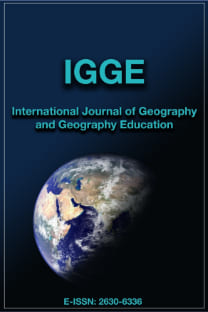21. YÜZYILDA ÇAĞDAŞ COĞRAFYA BİLİMİ VE TEMEL UNSURLARI
Coğrafya bilimi, terim olarak ilk
kullanıldığı 2200 yıldan bu yana saha, tanım araç-gereçler ve metot olarak çok
değişmiştir. Başlangıçta tasviri bilgilere dayalı olan coğrafya; günümüzde,
bilgisayar teknolojisi yardımıyla, sayısal teknik ve modellemelerin ağırlıklı
olarak kullanıldığı bir bilim dalı halini almıştır. Çağdaş şekli ile günümüz
coğrafyası, insanoğlunun tüm aktivitelerinde en üst düzeyde ihtiyaç duyduğu ve
yararlandığı, disiplinler arası bir bilim dalıdır. Gelişmiş ülkelerde coğrafya,
fiziki ve beşeri ortamı aralarındaki etkileşimlerle birlikte, insan yararına
inceleyen ve bu yolla insanın doğadan en üst düzeyde istifade etmesini sağlayan
bir bilim dalı olarak algılanmaktadır. Buna karşılık bazı gelişmekte ve geri
kalmış ülkelerde ise coğrafya, sadece dağ ve nehir adlan ile ülke başkentlerini
ezberlettiren bir sosyal bilim olarak ele alınmaktadır. Coğrafyanın bu çağdışı
şekliyle ele alınması, bu ülkelerde beşeri, ekonomik, siyasi, sosyal ve
kültürel gelişme yönünden çok büyük dezavantajlara neden olmaktadır. Bu
çalışmada öncelikle, coğrafya biliminde geçmişten günümüze meydana gelen
değişimler gözden geçirilecek, sonrasında ise çağdaş coğrafya biliminin,
gelişmiş ülkelerdeki algılanış biçimi ile, temel unsurları üzerinde
durulacaktır.
The Geography Science and Its Main Components in the 21st Century
Geography Science has changed tremendously, in
definition, field, material, equipment, and methods, since the name was first
used 2200 years ago. Geography was initially based on descriptive information. It
is now a science that includes computer enhanced numerical techniques and
models. In its contemporary form, geography is a multi-disciplinary science
that people can use and benefit from in virtually every activity to varying
degrees. Geography within developed countries is perceived as a science that investigates
the physical and human environment and their mutual interactions, allowing
humans to benefit from the nature world at the highest level. Some developing
and underdeveloped countries, on the contrary, treat geography as a social
Science that teaches only the names of mountains, rivers, and capitals. This
antiquated view of geography creates a disadvantage in terms of human, economic,
social, and cultural development. In this study the changes in geographic
Science will be reviewed, from past to the present, and then the main
components of contemporary geography Science will be highlighted as it is
perceived in developed countries.
___
- AAG: The Association of American Geographers, http://www.aag.org.
- Bergman, F„ E., McKnight, T., L., 1993, Introduction to Geography, Prentice-Hall, Inc, USA.
- Christopherson, R., W., 1997, Geosystems: and ıntroduction to physical geography, Prentice-Hall, Inc. USA.
- Doğanay, H., 1993, Coğrafya’ya Giriş, “Metodlar, ilkeler ve Teminoloji”, Gazi Büro Kitabevi, Ankara.
- Getis, A., Getis, J., ve Fellmann, J., 1994, Introduction to Geography, Macmillan Publishing Co., Inc., USA. Geography Education Standards Project. Geography for Life: National Geography Standards, 1994, National Geographic Research- Exploration. Washington, DC. 1994.
- Haggett, P., 2001, Geography A Global Synthesis. Prentice Hail, USA.
- Stoddart, D. R„ 1986, On Geography: And Its History. Oxford, Blackwell.
- Tanoğlu, A., 1964, Coğrafya Nedir?, İ. Ü. Coğrafya Enstitüsü Dergisi, no: 4, s: 3-14, İstanbul
- Tümertekin, E., 1990, Çağdaş Coğrafi Düşüncenin Oluşumu ve Paul Vidal de la Blache, İstanbul Ünv., Edebiyat Fak., Yay. No 3603, İstanbul.
